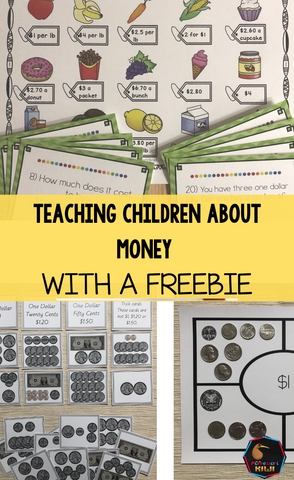
Teaching children about money (includes freebie)
Share
I was reading recently about how cash is only really used by children and the elderly and that for the rest of us we use our money electronically.
In this changing world how do we ensure children have a good knowledge of money?
What things do they need to know?
Many people would point to the practical life skills a child needs to have. Budgeting would be one thing, understanding the value of money as in its worth is also important to.
If we look at the link between currency and traditional maths there are some obvious things children need to know about. I've listed these in order from simple to advanced.
- Recognise notes and coins.
- Compare values.
- Skip count in 10s, 5s, 2s using money.
- Use money to make totals
- Find compatible numbers for totals such as 10, 20, 50 and 100.
- Use various dollar and coin amounts to make given totals.
- Linking to fractions e.g. half of a dollar is ..... 1/5th of a dollar is ......
- Round money amounts to the nearest 50 and 10.
- Use rounding to estimate totals (to 10 cents and then to the cent column).
- Create groupings using play money and place value materials.
- Make sensible estimates for sums.
- find the sum of groups of 10s, 100s, 1000s and mixtures of these denominations.
Wherever possible we need to be encouraging deep thinking to help students see how what they know about number links to money.
This can be done from an early level when a child is learning to count:

At a more advanced level it may look like this:

or this

I am a big fan of real life questions to help students understand numbers and how they apply to them. Visiting a shop and giving children a budget is one way to do this or you can use circulars or visit a shop online and have students "virtual" spend or budget a meal.

This is also a great time to help students learn to estimate. In this activity students estimate whether an amount is more or less than $5 or $10. The aim is for them to start to look at numbers and use quick mental strategies.
You can get a free download of it by clicking here

Those of you who have been following me for a while know that I am also a big advocate for helping students think of multiple ways of getting to an answer. Traditionally many parents have been educated to teach maths as question -> answer for example 2 + 2 = 4. However it is also important students learn other ways we could look at 4. We could pose the question as "what has a sum of 4?"
The following types of activities help students look at numbers from different perspectives and also encourage an important life outlook - there could be multiple ways at looking at a problem, object or event.


Linking fractions to money is a great way as well to bring fractions to life.
You can make a simple money fraction circle using the montessori fraction circle and having students use play money for different fractional amounts.

All of these activities can be accessed in my US Money Bundle which includes 300 pages of resources for students aged 3-9. It includes materials to teach money identification, counting, skip counting, money in real life situations, traditional math problems, open ended math problems and linking fractions to math.
Get the full bundle of activities here

1 comment
Thanks for this lesson.